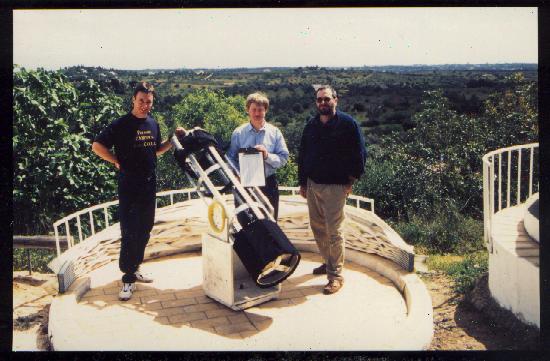
COAA, Portugal, 1998 March 29/30

L to R: Mark Dunnett, Paul Money and Stephen Tonkin
with the 12" Dob they used for most of the Marathon.
(Photo:
Nick Norman)
From some latitudes there are about 2 weeks of the year at the end of March/beginning of April when a complete Messier Marathon, that is the observation of all 109 (*) Messier objects in a single night, is theoretically possible. A group of us -- Mark Dunnett, Paul Money (both Boston Astronomers), my son Timothy Tonkin (aged 11 yrs) and I (both Wessex AS) -- went with our families to COAA, the Centre for Observational Astronomy on the Algarve, which is at an appropriate latitude, and took advantage of the dark of the Moon at the end of March, 1998, to attempt this feat.
Preparation is the key to a successful marathon and we were fortunate in that Paul had successfully completed it at COAA in 1993 and that Bev Ewen-Smith, who runs COAA, also gave us the benefit of his advice and experience. The immediately obvious areas of preparation are:
Less obvious areas include:

M51 – the Whirlpool Galaxy
(SX CCD, 120s unguided, 6" f/6 Newtonian; North is up; N.
Norman & S. Tonkin; 1998 April 01)
The partly cloudy skies cleared on March 26, the night of the New Moon, and we began our attempt in the evening, some 5 days later in the year than Paul's previous successful attempt. Because the observing platforms at COAA do not afford a view of the western and north-western horizons, we carried the 150mm and its altazimuth pedestal around to the other side of the hill. As dusk fell, we began to identify the appropriate stars which would lead us to our first target, the 9th magnitude galaxy, M74, in Pisces. As soon as Hamal (alpha Ari) was visible to the naked eye, 10x50 binoculars enabled us to locate beta Ari and then eta Psc. The latitude difference affects the angle at which the constellations set, and getting orientated in bright twilight skies, with an unfamiliar telescope, can take longer than usual - I began to feel as if a "dummy run" may have been beneficial. Bev soon had M74 in the eyepiece and we began the process of mutual confirmation of observations. I was last to be able to see the object, though that I was able to at all was testimony to the marvellous Hinds optics in this telescope and Bev's 20mm Erfle, a superb eyepiece which gives a field of 1.3 deg in this instrument.
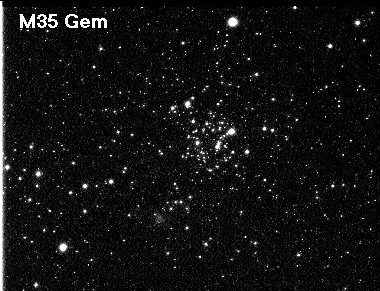
M35 & NGC2158
(Image: SX CCD, 10s unguided, 200mm f/4 camera lens; North is
up; P. Money, N. Norman & S. Tonkin; 1998 March 31)
M77 followed fairly easily a few minutes later, but the next target, M33, proved remarkably difficult in the telescope, although it was easy in 10x50 binoculars. This is typical of a large, low surface-brightness object which, in the telescope it appeared as no more than a slight brightening of the sky. Other objects in the western sky followed rapidly and, with 11 successful observations - 10% of the targets in just over 20 minutes - we turned to Lepus to observe the globular cluster, M79. The stars in that region of the sky began to dim as cloud rolled in from the west. I had my dummy run after all.
As we trudged around the hill back to COAA, resigned to our "defeat" but encouraged that the difficult evening twilight objects were possible for all of us, Bev's alertness to faint glimmers of light enabled us to share one further observation that evening: a glow-worm nestling in the grass between the lanes of the track.
The cloud hung around for several days, thinning and partially dispersing, but not quite doing so completely. Late in the afternoon of the 29th, Bev announced that he had been looking at both the sky itself and at the weather satellite images and thought that the sky would clear that evening and, if we were lucky, stay clear until dawn. Again we took ourselves and the telescope around the hill and, by the time we got there, the sky was crystal clear down to the horizon.
The dummy run had been worthwhile; the difficult galaxies were 12 minutes further into the twilight and potentially that much more difficult to observe, but the false start several days previously facilitated the task of finding them. M74 was observed at 19:54 (all times are UT) and three quarters of an hour later we had observed 28 objects. There was one stunning distraction - as twilight faded into night, a great triangle of brightness appeared in the western sky - for those of us used to the quality of British skies, this zodiacal light was an uncommon and magnificent phenomenon.
Back at the COAA observing platforms, we switched to the 300mm as our main instrument and, starting with the galaxies in Leo, continued working through our list. It was during this period that Timothy dropped out. He had been unable to see M101 in UMa, an object he has previously found relatively easily. We suspected that his decreased observing ability might be due to falling blood glucose, so he went back up to the house to have some sweet food. He came back down and made several more successful observations, but tiredness was taking its toll and he retired to bed, with our hearty congratulations on having observed 48 objects in two and a half hours - not a bad effort for a youngster of that age after an energetic day on the beach!
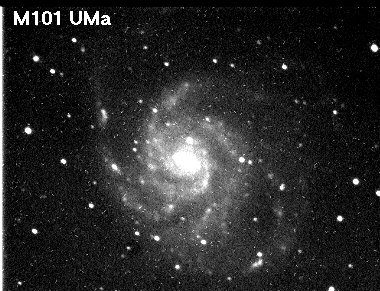
M101
(Image:
SX CCD, 240s unguided, 6" f/6 Newtonian; North is up; N. Norman & S.
Tonkin; 1998 April 01)
Bev departed to bed just after 23:00, promising to return in time for the daunting M30, which was intended to be our final observation. An hour later we had observed 72 objects and could afford to relax a bit until other objects became easily available. We re-fuelled ourselves and Mark showed us some of his favourite NGC and IC objects, and demonstrated the efficacy of his O-III filter, now another item for my "must have" list. Many objects, but especially planetaries, are magnificent with this filter. I had intended taking a sleep for a couple of hours during this period, but this relaxed diversion from our main task was such an enlivening experience that I decided it was probably more refreshing than sleep would have been. I also took the opportunity to renew my acquaintance with such delights as omega Cen (NGC 5139) and the Antenna Nebula (NGC4038/4039) which are respectively impossible and at very low altitude from the latitude of Britain. During this and other slack periods I also contented myself with binocular (10x50) observations of various open clusters.
As the night and tiredness progress together, the advantages of undertaking this sort of effort in a group become more and more apparent. The interests of my observing companions gave me an added interest, and the combination of Mark's quiet self-assuredness with Paul's irrepressible enthusiasm (and appalling puns!) did a great deal to carry us through the night. In an activity such as this, there are times when any of us can find normally easy-to-find objects to be unlocatable - my embarrassment was my failed attempt to find M13 in the keystone-shaped head of Draco! The encouragement of companions is invaluable at times like these, to stop such silly frustrations from becoming disheartening, as they can do in the course of a long night when tiredness can distort perceptions.

M104 – Sombrero Galaxy
(SX CCD, 60s unguided, 6" f/6 Newtonian; North is up; N.
Norman & S. Tonkin; 1998 April 01)
As the morning hours became cooler, we started suffering from dewing optics. We swapped eyepieces between a 26mm Plossl and a 25mm Kelner, the unused one being kept warm in my shirt pocket. More alarming was the dewing of the diagonal on the Dob. The telescope is of open frame construction and, although it has a cloth shroud at the top end, the diagonal was very exposed to the sky above when we were observing low- altitude objects. Soon after we first noticed it, Paul and I tried to warm it by cupping our hands around (but not touching) it for 10 minutes or so, hoping that the heat radiated from our hands would be sufficient to drive the dew away. When we removed our chilled hands, it became apparent that the evaporating perspiration from our hands had made the problem worse and the diagonal was now completely unusable. I went back to my room to get my "puffer" brush, hoping that a bit of forced evaporation might solve the problem. It was with some relief that I returned to find that the mirror had miraculously cleared in my absence; presumably the heat from our hands had been sufficient and the condensation from our hands was temporary.
Around 02:15 we noticed that the southern horizon was becoming murky to an altitude of about ten degrees. This murk was being illuminated by working lights on a building site several miles away, which were sufficiently bright to cast shadows at our observing site. As a consequence, low altitude objects were becoming increasingly difficult to observe, although the southern Milky Way was still remarkably bright where it rose above the murk. The normally bright nebulosity in M8 (the Lagoon Nebula) was almost lost until it rose above this murk, although the cluster was easily visible. Mark diverted us from the "bad news on the horizon" with spectacular views of, amongst other things, the Veil Nebula (NGC6960/6992) through his O-III filter - NGC6960 had the appearance of a mini Milky Way in the eyepiece, but with this filter the brighter part, NGC6992, was one of astronomy's "Wow!" experiences. An hour later we had notched up 100 objects with M69. When we observed M70 a little while later, Mark announced that had now observed all the Messiers, but I had still never seen M30.
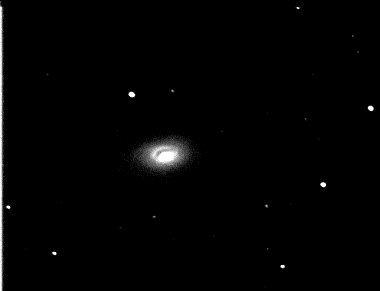
M64 – the Black-eye Galaxy
(Image: SX CCD, 60s unguided, 6" f/6 Newtonian;
North is up; N. Norman & S. Tonkin; 1998 April 01)
By this time my vision was becoming affected by tiredness; funny reticular moving patterns were appearing to swim in the eyepiece field, making faint objects somewhat difficult to see. A sweet drink helped to restore my vision, but M72 still proved to be extremely difficult for me to observe.
Although I have done several short all-nighters under late spring or early autumn UK skies and have often stayed out under the stars without actively observing all night when the nights are longer, this was the first time I'd spent actively observing for more than about 4 hours. The active observation makes one much more conscious of the sky and we were all affected by the sheer magnificence under which we, on our planet, revolve. In such situations it is easy to understand the profound effect the night sky had on our ancestors and I was not the only one to comment on the almost religious nature of the experience.
Thus filled with awe, I witnessed the rising of Venus, half an hour in advance of twilight, which signalled that our vigil would soon be over. M75 and M55 proved difficult to find in the murk (Well done, Paul!) but, once we had found M2, relatively easy now the horizon murk had slightly diminished, there was only the elusive M30 left, due to rise after the end of astronomical twilight.
Shortly after 05:00, Bev returned with fresh eyes and mind, and we shifted the telescope up the slope towards the house, having deduced that our target would be occulted by a tree if we remained on the observing platform. By 05:15 the others had all observed it but, even though I could find the nearby 41 Cap in binoculars, M30 had still eluded me in the telescope. The sky was noticeably brightening and I was in danger of becoming disheartened but, with a combination of hyperventilation (to increase the oxygen supply to my retina), averted vision and telescope-jiggling, the object not so much leapt as faded into view at 05:17. My description of its position in the eyepiece was confirmed and the marathon was over, some nine and a half hours after it began.
That last sentence makes it seem like an anticlimax and, in a sense, it was. Whilst I was pleased to have succeeded and knew that I had pushed my observing skills beyond their previous limits it is, after all, merely the observation of one particular set of 109 objects, with little time to enjoy the evening and morning twilight ones. However, the Messier Marathon itself was a vehicle to other things. The first is the sense of human comradeship that comes from a co-operative venture like this. I don't know if I could have achieved it without help and it seems clear that observing sessions of this kind are ideal activities for a society or a group of observers. The second is the sheer magic - there is no other adequate word - of the experience of active observation (and contemplation) of the sky for an entire night. It is for these that I would do something similar again - and I have the distinct impression that Paul is hatching some plan involving several hundred NGC objects!
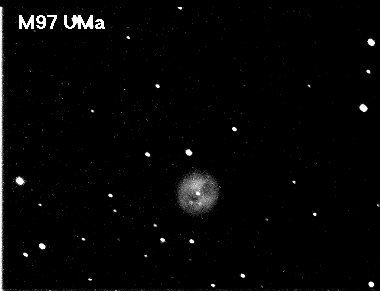
M97 – Owl Nebula
240s unguided, 6" f/6 Newtonian; North is up; N. Norman &
S. Tonkin; 1998 April 01
* Although there are 110 objects in Charles Messier's catalogue, there is some controversy over the identity of the object M102. This entry was made not by Messier himself, but by his friend Pierre Mechain, and the object could not subsequently be found. Until relatively recently it was considered that the object was the 10th magnitude galaxy NGC 5866 (an opinion that is still held by some astronomers), but the discovery of a letter from Mechain stating that his observation was in error and that it was a duplicate observation of M101 appears to solve the mystery of the "missing" object.
© 1999